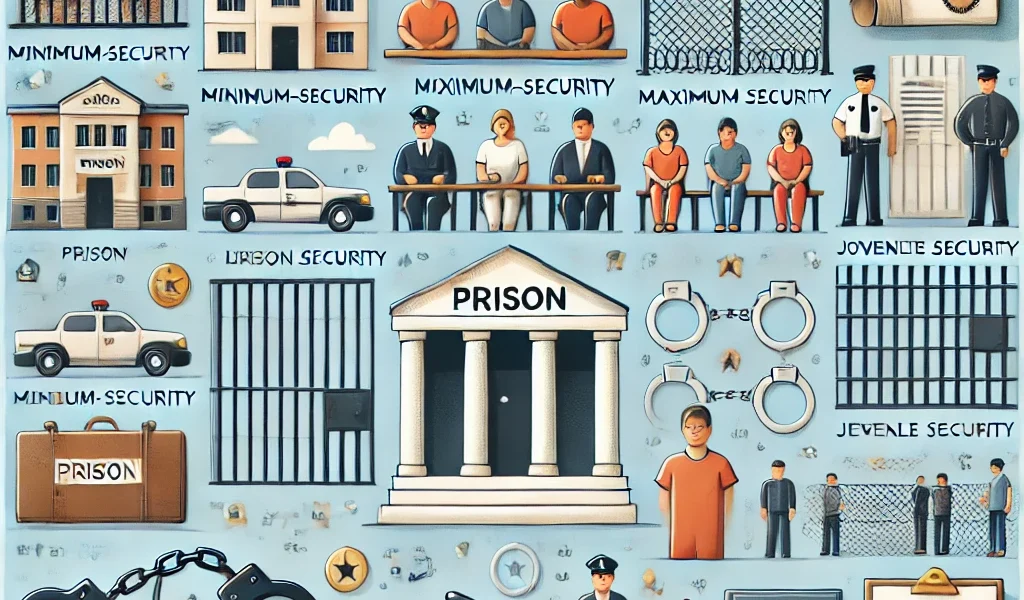Prison: Definition, Examples, Cases, Types, and Processes
Prisons have existed throughout human history as a means of punishment, rehabilitation, and social control. They serve various functions within a society’s justice system, housing individuals who have been convicted of crimes or are awaiting trial. The concept and use of prisons have evolved, reflecting changes in social attitudes, legal frameworks, and approaches to crime and punishment.
In this article, we will explore the definition of prison, examine examples and notable cases, delve into the types of prisons, and outline the processes involved in the incarceration system.
Table of Contents
- What is a Prison?
- Examples of Prisons
- Notable Prison Cases
- Types of Prisons
- Processes in the Prison System
- The Purpose of Prisons
- Conclusion
What is a Prison?
A prison is a facility used to confine individuals who have been convicted of crimes or are awaiting trial. Prisons are typically used for long-term incarceration, distinguishing them from jails, which are often for short-term detention. The individuals held in prisons are usually convicted of more serious offenses, including felonies, and are serving sentences that can range from a few months to life imprisonment.
Prisons serve various purposes within a society’s criminal justice system, including:
- Punishment: To impose consequences for criminal behavior.
- Rehabilitation: To provide opportunities for prisoners to reform and reintegrate into society.
- Deterrence: To discourage both the incarcerated individual and others from committing crimes.
- Protection: To keep dangerous individuals away from society to protect the public.
Prison vs. Jail
While the terms “prison” and “jail” are often used interchangeably, they refer to different types of facilities:
- Jails: Operated by local governments, they are typically used for short-term detentions, including holding individuals awaiting trial or serving short sentences.
- Prisons: Operated by state or federal governments, they are designed for long-term incarceration of individuals convicted of serious crimes.
Examples of Prisons
Prisons vary greatly depending on the country, type of inmates they house, and the goals of the institution. Here are a few notable examples of prisons around the world:
1. Alcatraz Federal Penitentiary (USA)
Located on Alcatraz Island in San Francisco Bay, Alcatraz was one of the most famous maximum-security prisons in the United States. Opened in 1934 and closed in 1963, it housed some of the most notorious criminals of its time, including Al Capone. Known for its harsh conditions and isolation, it became a symbol of the tough penal system of the mid-20th century.
2. ADX Florence (USA)
Also known as the “Supermax” prison, ADX Florence in Colorado is the highest-security federal prison in the U.S., designed to hold the most dangerous criminals, including terrorists and spies. Inmates here spend the majority of their time in solitary confinement, often for 23 hours a day.
3. Bastøy Prison (Norway)
In contrast to the traditional view of harsh prisons, Bastøy Prison in Norway is known for its progressive approach to rehabilitation. Located on an island, the prison houses inmates in an open, community-style setting. The focus is on reintegration into society, with inmates given access to education, work, and leisure activities. Norway’s prison system is highly regarded for its low recidivism rates.
4. Robben Island (South Africa)
Robben Island, off the coast of Cape Town, is historically significant as the place where Nelson Mandela and other political prisoners were incarcerated during apartheid. It has since been turned into a museum and World Heritage site, serving as a reminder of the struggle for freedom and justice.
Notable Prison Cases
Several high-profile prison cases have drawn attention to issues such as wrongful convictions, prison conditions, and human rights violations. Here are some key examples:
1. Nelson Mandela
Nelson Mandela, the former President of South Africa, spent 27 years in prison, including 18 years on Robben Island, for his opposition to apartheid. His imprisonment became a symbol of the struggle against racial injustice, and his eventual release in 1990 marked a turning point in South African history.
2. The Exoneration of the Central Park Five (USA)
In 1989, five teenage boys were wrongfully convicted of assaulting a woman in Central Park, New York City. They spent years in prison before DNA evidence and a confession from the actual perpetrator exonerated them in 2002. Their case highlighted serious flaws in the U.S. criminal justice system, including issues of racial profiling and coerced confessions.
3. Oscar Wilde
The renowned playwright Oscar Wilde was sentenced to two years of hard labor in British prison for “gross indecency” due to his homosexuality in 1895. His imprisonment took a severe toll on his health and career, and his case remains a prominent example of persecution based on sexual orientation.
Types of Prisons
Prisons can be classified based on their level of security, the type of inmates they house, and their intended function. Here are the main types:
1. Minimum-Security Prisons
These facilities are designed for inmates considered low risk, often white-collar criminals or non-violent offenders. The environment is more relaxed, with less strict supervision, and inmates may have access to educational or vocational programs. Inmates are usually housed in dormitory-style settings rather than cells.
2. Medium-Security Prisons
Medium-security prisons house inmates who are considered a higher risk but not dangerous. These prisons have more restrictive security measures, including barred cells and controlled movement, but still offer some rehabilitation programs and opportunities for work.
3. Maximum-Security Prisons
Maximum-security prisons are designed to house the most dangerous offenders, including those convicted of violent crimes. Inmates are often confined to cells for most of the day, with strict security measures in place. These prisons prioritize security over rehabilitation.
4. Supermax Prisons
Supermax prisons are the highest-security facilities, designed for inmates considered an extreme risk to others, including terrorists, organized crime leaders, and violent repeat offenders. Inmates are typically kept in solitary confinement with minimal human contact.
5. Juvenile Detention Centers
These facilities are designed specifically for offenders under the age of 18. Juvenile detention centers focus on rehabilitation and education, rather than punishment, with the goal of helping young offenders reintegrate into society.
Processes in the Prison System
The process of incarceration begins long before an individual enters a prison. It involves several key stages:
1. Arrest and Booking
When an individual is suspected of committing a crime, they are arrested by law enforcement and taken to a police station for booking. This includes recording the suspect’s personal information, fingerprinting, and taking their photograph.
2. Pretrial Detention or Bail
If the crime is serious, the individual may be held in jail until their trial. In some cases, they may be released on bail, a financial guarantee that they will appear for their court date.
3. Trial and Sentencing
If convicted at trial, the individual is sentenced to a period of incarceration. The length and type of sentence depend on the severity of the crime and the laws of the jurisdiction. Some sentences also include the possibility of parole.
4. Incarceration
Once sentenced, the individual is transferred to a prison to serve their sentence. While in prison, inmates may participate in educational or work programs, receive medical care, and interact with other inmates under strict rules.
5. Parole or Release
Inmates may be released early on parole, a supervised release program, if they meet certain conditions. If they serve their full sentence, they are released without supervision, though they may still face restrictions such as registering with local authorities, depending on the nature of their crime.
The Purpose of Prisons
The role of prisons varies depending on the society and legal system in which they exist. Broadly speaking, prisons serve four main purposes:
- Retribution: Prisons punish individuals for breaking the law, reinforcing societal norms and deterring criminal behavior.
- Rehabilitation: Some prison systems focus on helping inmates reintegrate into society through educational, vocational, and psychological programs.
- Incapacitation: Prisons remove dangerous individuals from society, preventing them from committing further crimes during their incarceration.
- Deterrence: By imprisoning criminals, the justice system seeks to deter both the individual and the general public from engaging in criminal behavior.
Conclusion
Prisons play a critical role in maintaining law and order, but they also face significant challenges, including overcrowding, human rights issues, and debates over their effectiveness in rehabilitating offenders. Understanding the types of prisons, the processes involved, and the purposes they serve is essential for an informed discussion on criminal justice reform and the future of incarceration.
Through notable examples and high-profile cases, we can see the diverse ways in which prisons have impacted individuals and society as a whole. While their primary function remains the same—to confine and manage those who break the law—their approach and effectiveness continue to evolve.




